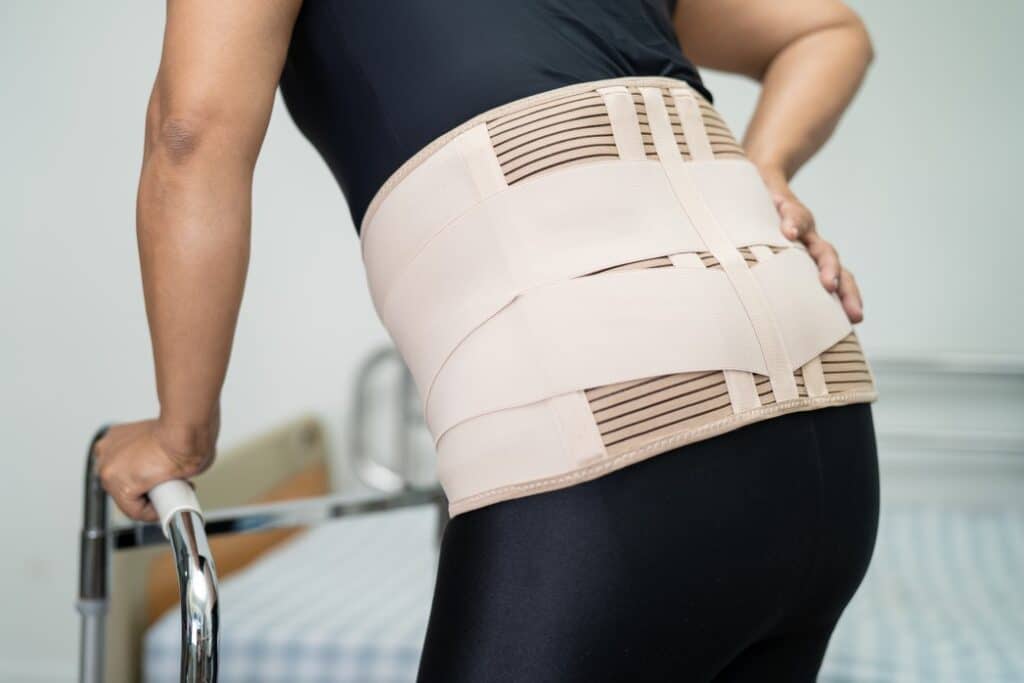

Lumbar Facet Injection
What Is a Lumbar Facet Joint?
Lumbar facet joints are sets of tiny joints between the vertebrae located in the back of the spine. The joints have opposite cartilage surfaces, which restricts frictions between the bones.
The synovial fluid surrounds the joint and acts as lubrication to further limit friction between the bones that rub together.
Healthy facet joints will support your spine, allowing you to twist and bend easily. However, your joint can become very painful and heavily inflamed due to various medical conditions such as trauma from car crashes, spinal stenosis, or degenerated discs.
What is a Lumbar Facet Injection?

Lumbar facet joint injections are frequently used to help in the diagnosis of the source and location of discomfort, as well as to provide pain relief.
Numbing medicines are injected into the facet joints to determine whether or not the facet joint is causing the patient’s suffering by studying the patient’s immediate pain decrease.
Is a lumbar facet injection the same as an epidural in terms of effectiveness?
Although both therapies are designed to relieve pain, they address distinct underlying diseases. Having epidural injections is recommended if you have back discomfort that radiates to your arms or legs.
On the other hand, Facet injections are administered into the facet joints of individuals suffering from degenerative diseases.
What conditions can Lumbar Facet Joint Injection treat?
Facet joint injections can treat neck and back pain in combination with non-surgical spine treatments such as rest, medication, chiropractic manipulation, and physical therapy.
How soon after the injection into the lumbar facet joint does it start to work?
For quick relief, facet joint injections with steroids are ineffective. Most patients feel a reduction in pain between two and seven days after surgery.
When the injection is administered, it will be accompanied by some relief from pain from the local anesthetic used.
Are you asleep during Lumbar facet injections?
When utilized as a diagnostic technique, facet joint injections are frequently used to isolate and confirm the particular site of a patient’s discomfort.
The injection is performed under intravenous sedation, meaning unconscious, and is performed while you are lying on your stomach, as described above.
Is it painful to get a Lumbar facet joint injection?
Facet Joint Injections is safe and simple.
Although the initial injection of a numbing drug, a local anesthetic, may pinch a little. The injection site may be a little sore afterward.
How Do Lumbar Facet Joint Injections Affect the Body?
If a facet joint injection is performed, the following risks and/or effects may arise:
- Allergy to X-ray contrast media or steroids is the most common cause of this reaction; local anesthetics are the culprit of only a small percentage of cases.
- Bleeding: Even though bleeding is a rare complication, it is more likely among people who already have bleeding issues or using blood thinners.
- Minor infections occur in between 1% and 2% of all injections, totaling 1 million injections. According to the CDC, severe infections are sporadic, occurring in approximately 0.1 percent to 0.1 percent of all injections. Continue reading this article to learn more about spinal infections.
- The discomfort at the injection site and the aggravation of pain sensations are usually mild and transitory. The occurrence of pain that endures for a lengthy period is rare.
- Even though spinal cord or nerve damage is extremely rare, it can occur due to needle trauma, infection, hemorrhage, or injection into an artery that obstructs the blood supply.
Along with the dangers associated with the injection, some individuals may develop adverse effects from the steroid medicine, including the following:
- For several days, some people experience transient flushing accompanied by a sensation of warmth (dubbed “hot flushes”).
- Excessive thirst, weight gain, or appetite
- Hypertension (excessive blood pressure)
- Symptoms include bipolar disorder, irritability, anxiety, and insomnia.
- In the event of hyperglycemia, people with diabetes should call their health care providers before the appointment for injectable therapy.
- Immune system deterioration during a period
What is the success rate of Lumbar Facet Injections?
Facet joint injections comprise a mix of analgesics that are released immediately and cortisol that is released slowly.
When the patient is correctly diagnosed, and the appropriate area is treated, facet joint injections have a success rate of 75%.
Lumbar Facet Injections: Before and After the Procedure

Procedures may be stressful, but if you know what to expect, this information will help you plan ahead of time. You’ll also be more prepared for your therapy if you do your homework beforehand.
Preparation for the procedure
- Plan a ride home with a friend or loved one ahead of time. After obtaining an anesthetic or taking pain medication, you should not drive.
- Become familiar with the exact operation being performed, as well as the risks, advantages, and other alternatives available to you.
- It’s detrimental that your doctor knows about all of the medications and natural remedies you’re using. Several drugs might make the surgery more dangerous, but your doctor will tell you whether to quit any of them before surgery, as well as how soon you should discontinue them.
- If you are currently taking aspirin or another blood thinner, consult your doctor to determine whether you should discontinue use prior to your treatment. It’s crucial that you understand everything your doctor has asked you to do.
- Confirm that your doctor and the hospital know your advance care planning. For those who have not yet put one together, you should consider doing so. It’s a wise precaution before undergoing surgery or medical treatment. It tells others what kind of care you’d want to get.
Following the procedure
When the numbing drug wears off, and the cortisone starts to act, patients may suffer a transient increase in discomfort that lasts several days.
It is common for doctors to suggest the following treatments throughout the week following an injection:
- If the area is uncomfortable for the first two to three days after receiving the injection, gently applying ice or a cold compress to the general area of the injection site will sometimes relieve discomfort.
- After completion of the therapy program, patients can take their standard pain medication
- After treatment, patients should be able to return to their everyday routines.
- Patients may be referred for physical or manual therapy to ensure that the anesthetic and/or cortisone are working correctly. In order to verify if the cortisone is working as intended, this might extend for several weeks or even months.
- The next day, if the soreness has reduced, it is advised that you resume your regular exercise and activities in moderation. Even after significant pain relief, it’s critical to gradually increase activity levels over one to two weeks to avoid the risk of recurrence.
Check out our article to learn more about physical therapy to treat low back pain.
How Effective Is a Lumbar Facet Injection?
Different treatments have different success rates for facet joint injections and medial branch blocks.
Research shows that around 92% of patients who received the injection may experience pain reduction for approximately one to four weeks after receiving an injection. Depending on the individual, symptoms may or may not recur in the future.
What Does A Lumbar Facet Injection Entail?
Treatment of facet joints with injections: This technique is minimally invasive and can be finished in as little as one to two hours. An average procedure will take no more than 15 minutes to perform.
- Patients are frequently given only a local anesthetic initially, but they may be given complete anesthesia in rare cases.
- Patients will be instructed to lie face on their stomach to begin the process. Preparation of the injection site and application of a topical numbing agent will be performed before giving the local anesthetic.
- Fluoroscopy, commonly known as a live X-ray, is usually used to perform a lumbar facet injection. Generally, this accurately guides the doctor to target the correct place to insert the needle.
- After the needle is in place, anesthesia and steroids are injected into the facet joint using a fluoroscopic tracer.
- The steroid reduces inflammation and irritation, while the anesthetic relieves pain and discomfort.
- Once in the spine, the combination drug works its way down to the lower levels and segments, reducing inflammation and irritation.
- Now, the needle will be removed, and the injection site will be bandaged with gauze.
Following-procedure care
- Pain scores would have been taken at the time of the surgery and will be retaken around 15-20 minutes following the procedure.
- At least 20 minutes after the incident occurs, keep an eye out for any immediate concerns. The patient should record a daily pain diary for the next two weeks as a reminder.
- After the therapy is over, the patient is usually taken home within two hours. A patient can never drive home following treatment if it takes more than two hours.
What happens after a lumbar facet injection procedure?
- The patient usually rests for twenty to thirty minutes in the recovery room following the procedure before being urged to engage in specific actions or activities that would ordinarily cause them discomfort.
- If the joints targeted are the primary cause of the patient’s suffering, he or she may or may not get instant pain relief following the injection. An injection will not provide immediate relief if the joint or joints targeted are not the source of the patient’s discomfort.
- In rare situations, patients may experience numbness, tingling, or a strange sensation in their neck or back for many hours following the injection.
- The patient and doctor will discuss any immediate pain treatment choices and any questions or concerns that the patient may have.
Steps to follow after a lumbar facet injection
- Patients should avoid strenuous activities and limit their use of pain relievers for the first four to six hours after receiving the injection.
- Following the injection, it is vital to obtain trustworthy diagnostic information from your surgeon or doctor.
- Unless your treating physician has expressly approved driving, do not attempt to operate a motor vehicle.
- For the next 24 hours, the patient should not drive after being sedated during the surgery.
FAQs:
Having received a Lumbar facet injection, can I safely operate a vehicle?
After receiving an injection, it's recommended that you stay away from driving for at least 24 hours.
Mild soreness is common for the first 24–48 hours following an injection. Nothing beats a good old-fashioned ice pack when it comes to pain relief. A 20-minute application of ice can be utilized
How long Is the recovery time for Lumbar Facet Injections?
Between two and seven days following surgery, most patients notice decreased discomfort. However, there will be some alleviation quickly after the injection is provided because of a local anesthetic.
Is it necessary to get a Lumbar Facet joint injection every few months?
?Lumbar facet treatments are merely a short-term remedy to the pain. Patients may need one or two further injections in the next six months.
You should not exceed three shots within a six-month time frame
Have You More To Ask About Lumbar Facet Injections?
If you live in the Phoenix area and have questions regarding lumbar facet joint injections, we invite you to call Atlas Pain Specialists.
We will thoroughly examine your injuries and medical records to determine the best course of action to relieve any pain and restore mobility. Schedule your same-day appointment today!
About Dr. Sean Ormond



